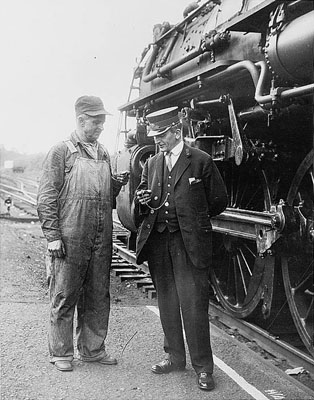 Approved Railroad Watches:
Approved Railroad Watches:
Each railroad either established their own requirements and had its own inspection service, or contracted an inspection service to ensure that all watches in use by specified personnel meet standard requirements. Different railroads accepted different watches. While some railroads listed specific makes and grades as acceptable, others just listed requirements. Not all watches manufactured as meeting railroad standards were approved by all railroads.
A standard watch is one that met the general time service requirements that were in effect at the time that it was built. Watch standards continued to evolve as time progressed and technology improved, however watches which met railroad requirement at the time they entered service typically could continue to be used as long as they remained in first-class condition and continued to meet the 30 second per week requirement.
American made 18-size, 15-jewel, patent regulator, "adjusted" pocket watches in both hunting and open face cases dominated railroad service during the later part of nineteenth century. Through the 1880's "adjusted" typically meant adjusted to isochronism, heat and cold, although the highest grade watch movements were also adjusted to positions.
Beginning in 1885 the General Time Convention worked to develope a Standard Code of Railroad Operating Rules, an industry code that is still in use. They began their work by sending questionnaires to member railroads. In April 1887 the General Time Convention adopted Rule 16 of the Standard Code:
"Each conductor and engineman must have a reliable watch, which has been examined and certified to on the form attached hereto, by a responsible watchmaker. Conductors and enginemen entering service must file such a certificate before they are allowed to take charge of trains or engines; and watches must be examined, and certificates renewed, every six months."
The certificate referenced specified "variation not to exceed thirty seconds per week." While adherence to the Standard Code was voluntary, it represented best operating practices for the 1880's and was based on rules already in use by various railroad companies.
During the 1890's 18-size, 17-jewel pocket watches dominated sales for railroad service, with most being adjusted to positions by the middle of the decade.
By the first decade of the twentieth century new smaller model "16-size" pocket watches began to appear in significant quantities. Requirements for new watches to be used in railroad service changed - eventually only open-face watches were allowed, fewer 18-size movements were allowed, and the minimum number of jewels was increased to 17 jewels, 21-jewel watches became popular. The marking "Adjusted" gave way to "Adjusted 5 Positions" and just about all new standard watches were fitted with a double roller. Total 16-size watch movement production exceeded 18-size watches by 1915. By the mid-1920's production of 18-size railroad grade movements had ended.
Lake Shore & Michigan Southern Railway Co. - 1891
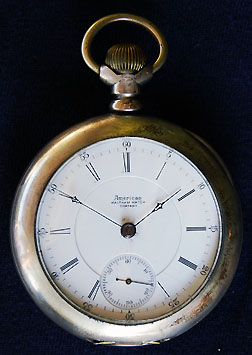 Instructions issued by Webb C. Ball, Chief Inspector of Watches, on August 15, 1891 indicated the standard adopted by the Company for its employes' watches now in service is one is equal to what is generally known among American movements as the "15-jewels, Patent Regulator, adjusted." Ball indicated this quality of movement "is represented by the Elgin Raymond and No. 70, by the Waltham No. 35 and Crescent Street, by Hampden Perry and Railway, Nos 59 and 60, by the Howard 'Gilt Heat and Cold,' and all grades above those named."
Instructions issued by Webb C. Ball, Chief Inspector of Watches, on August 15, 1891 indicated the standard adopted by the Company for its employes' watches now in service is one is equal to what is generally known among American movements as the "15-jewels, Patent Regulator, adjusted." Ball indicated this quality of movement "is represented by the Elgin Raymond and No. 70, by the Waltham No. 35 and Crescent Street, by Hampden Perry and Railway, Nos 59 and 60, by the Howard 'Gilt Heat and Cold,' and all grades above those named."
New watches were to be "higher grade which quality is represented by the Hampden New Railway and New No. 60, by the Waltham Crescent Street, by the Howard 'Gilt Heat and Cold,' and all grades equal quality and above."
Ball required watch inspection every two weeks and rejected watches which did not meet standards in order to ensure accuracy and facilitate safe railroad operation.
Erie Railroad - 1891
The Erie Railroad published watch requirements in September 1891. "A.H. Murphy, the jeweler, has been appointed inspector for Erie Railroad of the watches to be carried by all engineers, firemen, conductors, brakemen and yardmasters employed by the Lake Shore road. Each employe must own and carry a watch with not less than fifteen jewels, patent regulator, adjusted to heat and cold, and subject to inspection at least once in two weeks by Mr. Murphy." The Jewelers’ Circular - Weekly And Horological Review, September 23, 1891.
Illinois Central Railroad Co. - 1892
The Illinois Central Railroad Co. announced the inauguration of a system of watch inspection on June 15, 1892, which was reported in The Jewelers' Circular - Weekly and Horological Review July 6, 1892, indicated the minimum standard of excellence adopted "for watches is of a grade equal to what is known among American movements as fifteen-jewel, patent regulator, adjusted to heat and cold, the variation of which must not exceed 30 seconds per week."
Employees were required to submit their watches for quarterly examination and for weekly comparison with standard time to the various local inspectors who have been appointed for the purpose, and who will be under the general supervision of Giles, Bro. & Co., who were appointed general inspectors. The rules applied to train masters, train dispatchers, enginemen, trainmen, towermen, yard masters, assistant yard masters, depot masters, station agents, engine foremen, and to bridge and section foremen.
General Railroad Timepiece Standards - 1893
The railroad industry was called upon to create standards for watches which all railroads would eventually follow. By 1893 the General Railroad Timepiece Standards Commission presented new guidelines, referred to as the General Railroad Timepiece Standards,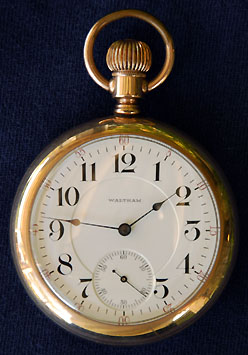 which required watches in use by employees responsible for train movement meet the following recommended minimum standards:
which required watches in use by employees responsible for train movement meet the following recommended minimum standards:
- Be open face (no lid over the dial), size 18 or 16 (Lancashire Gauge for measuring watches, as measured at the dial plate, size 18 equals 1 23/30" or 44.86 mm, size 16 equals 1 11/16" or 43.18 mm) read more about watch sizes
- Plain white dial, bold black hands, and bold Arabic numbers
- Have the winding stem at 12 o'clock
- Be lever set (to set the time, the case had to be opened, lever pulled out to set the hands, to prevent an accidental change, rather than pendant set)
- Have a minimum of 17 jewels, a double roller, steel escape wheel, micrometric regulator and grade on back plate
- Be adjusted to at least 5 positions (stem up, left side up, right side up, face up and face down)
- Temperature compensated for 34 to 100 degrees Fahrenheit
- Keep time accurately to within a gain or loss no more than than 30 seconds a week
Following the adoption of the 1893 General Railroad Timepiece Standards, watch manufactures designed watches to meet railroad standard requirements. It should be pointed out that many of railroads did not adopt all of these recommended standards for another decade. In publishing watch requirements railroads commonly continued to accept roman numerals on dials, open-face pendant-set watches and a minimum of 15-jewels watches, until 1906-1908. Some railroads continued to accept hunting case watches with hunting case movements into the 1920's. Watches adjusted to 3 positions, rather than the recommended 5 positions, were generally accepted in railroad service until around 1907, with some railroads including the ATSF continuing to accept them into the 1920's.
Cleveland, Cincinnati, Chicago & St. Louis Railway Co. - 1898
The Jewelers' Circular & Weekly Horological Review reported on March 2, 1898 that the Cleveland, Cincinnati, Chicago & St. Louis Railway Co. and the Peoria & Eastern Railway Co. had issued new requirements for all new watches placed in service, to be of the highest grades and most carefully finished and adjusted American made watches, represented by the Howard Nickel 18-size New 1896 Model; by the Waltham Vanguard and Crescent Street "Vanguard Model" (1892 model), both open face and hunting; by the Illinois Watch Co. Bunn Special, both open face and hunting; by the Hampden Special Railway, both open face and hunting; by the Elgin Nos. 181, 149 and 150, and by the Ball Official Standard Watches. All watches placed in open face cases must wind at figure 12.
The "old" watches currently in service were required to be of a minimum standard grade equal to what are known among American watches as the "15-jewels, patent regulator, adjusted" and must be in condition to keep time within 30 seconds per week.
Web C. Ball - 1906
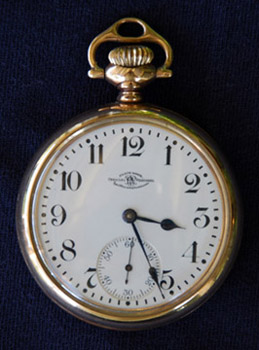 Webb C. Ball built a time service which
grew to control the inspection of watches railmen used on half of the U.S.'s railroads, according to Ball. Webb C. Ball published the following list of watches approved for railroad use by the Ball Time Service in The Jewelers' Circular Weekly and Horological Review in January 1906:
Webb C. Ball built a time service which
grew to control the inspection of watches railmen used on half of the U.S.'s railroads, according to Ball. Webb C. Ball published the following list of watches approved for railroad use by the Ball Time Service in The Jewelers' Circular Weekly and Horological Review in January 1906:
American Waltham Watch Co.
Ball Watch Co.
Elgin Watch Co.
Hamilton Watch Co.
Hampden Watch Co.
Illinois Watch Co.
Rockford Watch Co.
Santa Fe Railway Revised Watch Inspection Rules effective September 1, 1921
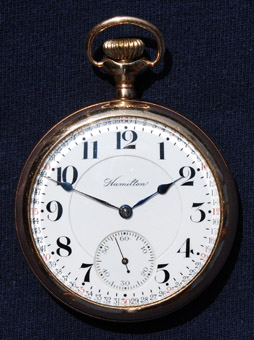 Prior to September 1, 1921 only conductors, engineers, yardmasters, assistant yardmasters and foremen of switch engines were required to carry standard watches. Effective September 1, 1921 this list was extended to include brakemen and flagmen, train porters, firemen, hostlers, herders, switch tenders and pilots. Instead of weekly inspections, watches were to be inspected semi-monthly. (as published in the Santa Fe Magazine, July 1921, pg. 62)
Prior to September 1, 1921 only conductors, engineers, yardmasters, assistant yardmasters and foremen of switch engines were required to carry standard watches. Effective September 1, 1921 this list was extended to include brakemen and flagmen, train porters, firemen, hostlers, herders, switch tenders and pilots. Instead of weekly inspections, watches were to be inspected semi-monthly. (as published in the Santa Fe Magazine, July 1921, pg. 62)
Requirements for a Standard Watch after May 15 are as follows:
- 17 or more jewels
- lever-setting
- adjusted to three positions, pendant up, dial up and dial down
- adjusted to temperature and isochronism
- Breguet hair-spring
- steel escape wheel
- double-roller escapement
- open face case with winding stem at "12"
- perform within a limit of error not exceeding thirty seconds per week.
Watches in service or owned by employees conforming to the standard requirements heretofore in effect, if in first class condition, will be continued in service, but those obligated to secure watches must observe the changed requirements.
Non-breakable glass was not permitted as it was of a composition that could bend under pressure sufficiently to stop the hands on watches rendering it unsafe for railway service.
Southern Pacific Railroad Watch Standards — July 12, 1923
On July 12, 1923 the Southern Pacific Company established its own Bureau of Time Service for the Pacific System, S.A. Pope was appointed Supervisor. The Bureau was responsible for the semi-monthly inspection of watches owned by 12,000 employees by 105 Watch Inspectors. Watches were to be cleaned and oiled once each year, in no case to exceed 18 months, loaner watches were provided to employees at no charge while their own were undergoing service. (as published in the Southern Pacific Bulletin, August 1923, pgs. 3-7)
"The product of all representative American watch factories are acceptable, if the watches meet certain specifications which are briefly described as follows:
- 16-size.
- Adjusted to 5 positions, viz: dial up, dial down Pendant up, pendant right, pendant left.
- Adjusted to temperature.
- A double roller escapement; steel escape wheel; 19, 21, or 23 jewels; lever set.
- Plain Arabic dial; plainness and clear reading of the dial being paramount where lights are uncertain such as in the cab or the caboose or by the light of the trainman's lamp.
- Watches in railroad service may not vary to exceed 30 seconds per week."
Santa Fe Railway Approved Watches — February 1, 1929 (All 16 size)
Rule 2. The regulation watch designated as standard, is described as follows: "16 size, American, lever-setting, 19 jewels or more, open face, winding at "12", double roller escapement, steel escape wheel, adjusted to 5 positions, temperature and isochronism, which will rate within a variation not exceeding more than 6 seconds in 72 hour tests, 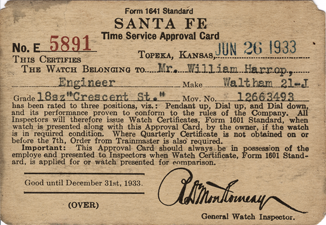 pendant
up, dial up, and dial down, and to be regulated within a variation not exceeding
30 seconds per week".
pendant
up, dial up, and dial down, and to be regulated within a variation not exceeding
30 seconds per week".
The following listed makes and grades meet the requirements and comprise a complete list of watches accepted:
American Waltham Watch Co. |
|
Ball Watch Co. |
|
Elgin Watch Co. |
|
Hamilton Watch Co. |
|
Hampden Watch Co. |
|
Howard Watch Co. |
|
Illinois Watch Co. |
|
South Bend Watch Co. |
|
Watches were also required to be protected with a suitable guard or chain. Watches also needed to have white enameled dials with black figures in upright position. Glasses were required to be replaced when badly scratched, cracked or chipped at the edge. Non-breakable glasses were prohibited. (as published in The Atchison, Topeka and Santa Fe Railway System: Rules Governing Time Service for Employees in Train, Engine, Yard, Roadway and Station Service, Effective February 1, 1929, Form 1645 Standard)
Union Pacific Watch Requirements - June 1936
All new watches must be 16 size with double roller, adjusted to 5 positions and so stamped on plates, lever set, plain Arabic numbers, open faced and wind at 12:00, maintain a rate of 30 seconds.
Watches listed as meeting the New Standard:
Santa Fe Railway Approved Watches — Revised October 1, 1938
Rule 2. (a) The regulation watch designated as standard, is described as follows:
16 size, American, lever-setting, 19-jewels or more, open face, winding at "12", double roller escapement, steel escape wheel, adjusted to 5 positions, temperature and isochronism, which will rate within a variation not exceeding more than 6 seconds in 72 hour tests, pendant up, dial up, and dial down, and to be regulated within a variation not exceeding 30 seconds per week.
(b) The following listed makes and grades meet the requirements and comprise a complete list of watches accepted: Watches bearing the name of jewelers, or other names not standard trade marks, or trade numbers, will not be accepted:
American Waltham Watch Co. |
|
Ball Watch Co. |
|
Elgin Watch Co. |
|
Hamilton Watch Co. |
|
Hampden Watch Co. |
|
Howard Watch Co. |
|
Illinois Watch Co. |
|
South Bend Watch Co. |
|
Watches were also required to be protected with a suitable guard or chain. Watches also needed to have white enameled dials with black figures in upright position. Glasses were required to be replaced when badly scratched, cracked or chipped at the edge. Non-breakable glasses were prohibited. (as published in The Atchison, Topeka and Santa Fe Railway System: Rules Governing Time Service for Employees in Train, Engine, Yard, Roadway and Station Service, Effective February 1, 1929, Revised October 1, 1938, Form 1645 Standard)
Union Pacific Railroad Company, July 1, 1946
Watch Standards
35. The minimum standard for excellence for watches NOW IN SERVICE shall be an American movement, 19-jewel, lever set, adjusted to five positions, patent regulator, and in such condition as will rate within a variation of 30 seconds per week.
36. The following will govern the standard for NEW RAILROAD WATCHES:
Ball Watches |
|
Elgin Watches |
|
Hamilton Watches |
|
Illinois Watches |
|
Waltham Watches |
|
Note. The minimum movement numbers shown above will govern new railroad watches January 1, 1946.
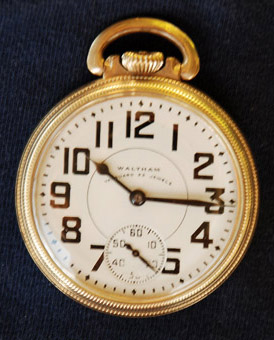 37. All watches entering service below the minimum movement numbers (19-jewel or more), must be accompanied by "Certificate of Watch Inspection and Record of Comparison", identifying the watch as having been previously used under time service rules of the Union Pacific Railroad or any other railroad within a variation of 30 seconds per week.
37. All watches entering service below the minimum movement numbers (19-jewel or more), must be accompanied by "Certificate of Watch Inspection and Record of Comparison", identifying the watch as having been previously used under time service rules of the Union Pacific Railroad or any other railroad within a variation of 30 seconds per week.
38. New watches below the minimum movement numbers may be accepted when accompanied by a bill of sale certifying that the movement was new when purchased by the employee, and that it had not been previously used or repaired. The bill of sale must be taken up by the time inspector and forwarded to the superintendent's office.
39. All new watches entering service must be 16-size, American make, lever set, plain dial, double roller, 19 jewels or more, steel escape wheel, adjusted to five or more positions and so stamped on their plates, in open face cases, wind at figure 12, and rate within a variation of 30 seconds per week. 12-size watches are not permitted.
40. Watches bearing names other that the standard trade marks, or trade numbers, will not be accepted for watches entering service. All watches will be identified by the manufactures' name and trade mark, or trade number, plainly stamped on their plates.
41. All watches entering service must have plain white enamel dials, with black Arabic figures and all numerals in an upright position. Marginal, luminous, Roman, gold or silver finished dials or metal dials are prohibited.
42. Watches will be equipped with black enamel spade hands, consisting of one hour, one minute and one second hand. Additional and other type hands are not permitted.
43. Glass crystals only will be used on standard watches. So-called non-breakable, indestructible, or celluloid crystals are not permitted, due to their tendency to warp under heat and to absorb moisture which will rust the hands, pinions and plates. Crystals which are cracked or chipped must be replaced, as particles of glass may stop the watch.
44. Employees are not permitted to place photographs, stickers or writing of any character on dials, in cases, or on crystals of their watches.
45. All watches will be protected with a chain or guard.
46. Time inspectors will refuse to inspect or compare any watch presented in violation of these rules and will promptly report circumstances to general supervisor of time service and superintendent.
Cleaning and Repairing of Watches
Unless watches are equipped with anti-magnetic balance wheels and hair springs, they should not be exposed to the influence of powerful magnetic fields, such as generators, unshielded dynamos, transformers, magneto-electric machines, radios or magnetic cranes. Occasional checks of watches for magnetism should be made by time inspector and if found to be magnetized sufficiently to affect the rate, the magnetism should be removed without cost to the employee.
Watches of employees subject to time service ruses must be cleaned and oiled within eighteen months of date they enter service as a new watch or from date of last cleaning and oiling. Superintendents will notify employees the date watches are due for cleaning.
Only genuine factory material will be used in replacing defective and worn parts of watches.
When a standard watch is left with a designated time inspector for cleaning and oiling and/or repairing, a standard certified loaner will be loaned the employee without charge.
As published in Form 7528 Union Pacific Railroad Company, Rules and Instructions Governing Time Service, Effective July 1, 1946, Eastern and South-Central District.
Post World War II Composite List
In the 1940's, some railroads specified minimum serial numbers of the different watch grades for acceptance. This is likely to correspond in part to the growing use of diesel-electric locomotives, and the anti-magnetic property of Elinvar used by Hamilton, and its equivalent used by Waltham and Elgin.
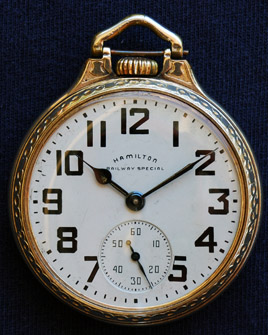
Minimum Serial Numbers Accepted After WWII on Some Railroads |
|||
| Make | Grade | Jewels | Min S/N |
|---|---|---|---|
| Waltham | Vanguard | 23 | 31,328,730 |
| Elgin | B. W. Raymond | 23 | 38,300,000 |
| Elgin | B. W. Raymond | 21 | 42,371,527 |
| Hamilton | 950 | 23 | 2,625,000 |
| Hamilton | 992 | 21 | 2,620,000 |
| Hamilton | 992B | 21 | C-001 |
| Illinois | Bunn Special | 23 | 5,665,000 |
| Illinois | Bunn Special | 21 | 5,665,000 |
| Ball | ORRS* | 23 | B648,500 |
| Ball | ORRS | 21 | B647,500 |
| Ball | ORRS | 21 | 1-B1 |
| *Official Rail Road Standard | |||
Wrist watches approved for railroad use
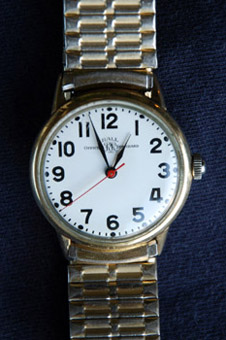 Railroad grade pocket watches remained the only watches approved for railroad service until the late 1950's when railroad
grade wrist watches were developed that could maintain the same accuracy. The "Trainmaster" with a Swiss made 21 jewel movement, introduced by Ball in 1959 and the "B.W. Raymond" with a 23 jewel American made movement, introduced by Elgin in 1960, were both high grade manual-wind wrist watches that were gradually approved for use on most American railroads. Ball later added a 25-jewel self-winding version of the watch.
Railroad grade pocket watches remained the only watches approved for railroad service until the late 1950's when railroad
grade wrist watches were developed that could maintain the same accuracy. The "Trainmaster" with a Swiss made 21 jewel movement, introduced by Ball in 1959 and the "B.W. Raymond" with a 23 jewel American made movement, introduced by Elgin in 1960, were both high grade manual-wind wrist watches that were gradually approved for use on most American railroads. Ball later added a 25-jewel self-winding version of the watch.
In 1962 Bulova introduced a railroad-approved version of their Accutron tuning-fork wrist watch using an electronic "214" movement. Hamilton also produced a railroad electric wrist watch using a Hamilton 505 movement which was briefly approved for use on some railroads, although it was later withdrawn due to issues with reliability.
SEIKO introduced wrist watches with a quartz movement in the early-1970's. The inherent accuracy and low cost of production has resulted in the proliferation of quartz clocks and watches since that time. Today railroad employees can still purchase SEIKO, Citizen, Pulsar and Invicta quartz wrist watches with railroad approved dials.
The Ball Watch Co. was family owned by direct descendants until the 1990s when the right to use the name was sold. The new firm continues to sell Ball watches, using Swiss-made (primarily ETA) high grade mechanical movements designed for sportsmen and railroads workers. The Ball product line continues to include Official Railroad Watches, perpetuating the traditions of the early BALL timekeepers.
Today the use of radios, automatic block signals, and central computer tracking of trains has lessened the role of the railroad watch on many railroads, yet watch requirements still remain important to safe railroad operation. On the Union Pacific, for example:
Rule 1.48 Time: While on duty, crew members must have a watch. Other employees must have access to a watch or clock.
The watch or clock must:
• Be in good working condition and reliable.
• Display hours, minutes, and seconds.
• Not vary from the correct time by more than 30 seconds.
• Be compared with the time source designated in special instructions.
Combined list of Railroad Grade Watches:
This is a combined list of railroad grade watches which is generally attributed Webb C. Ball. List appears to be from around 1908-1909. Not all of these were railroad approved even though all are railroad grade.
BALL WATCH CO.
COLUMBUS WATCH CO.
ELGIN
HAMILTON
HAMPDEN
E. HOWARD & CO.
HOWARD WATCH CO.
ILLINOIS
PEORIA WATCH CO.
ROCKFORD
SETH THOMAS
SOUTH BEND
UNITED STATES WATCH CO., MARION
U.S. WATCH CO., WALTHAM
WALTHAM (American Waltham Watch Co.)
Links to other sites for additional information:
Pocket Watch Database: - Serial number lookup and information for Hamilton, South Bend, Illinois, Rockford, Waltham & Elgin.
American Waltham Aurora Ball Columbus Elgin National Hamilton Hampden E.Howard Illinois Peoria Rockford South Bend Seth Thomas U.S.Marion U.S.Waltham
Railroad Time Railroad Clocks Railroad Watches Approved Watches Watch Manufactures
Sharing A Heritage Railroad History Train Technology Railroad Operation Railroad Time Museums & Heritage Railroads Railroads Today
